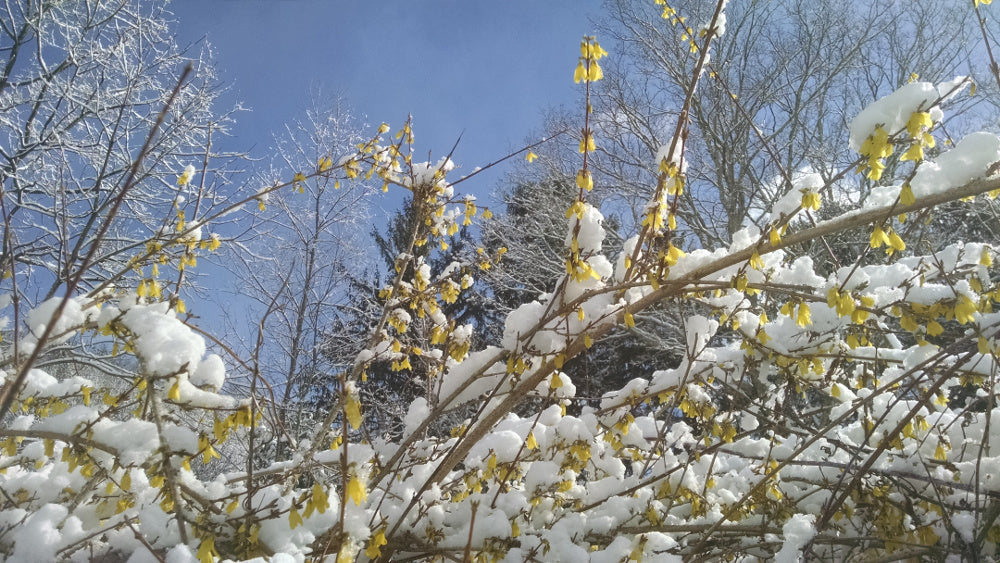 Here in the Hudson Valley, this morning was one for the record books. After five months of exceptionally above-average temperatures, winter finally decided to make an appearance. And it came in full force! Here at the Seed Library farm, we woke to a reading of 10 degrees Fahrenheit—by far the coldest temperature we have ever seen in April, and indeed record-breaking for this day in history.
Here in the Hudson Valley, this morning was one for the record books. After five months of exceptionally above-average temperatures, winter finally decided to make an appearance. And it came in full force! Here at the Seed Library farm, we woke to a reading of 10 degrees Fahrenheit—by far the coldest temperature we have ever seen in April, and indeed record-breaking for this day in history.
Like an unwelcome guest traipsing in at the end of a difficult-event-that-went-rather-well, the blast of cold and snow over the past few days has managed to disrupt our early, bloom-filled spring. We were doing alright, moving on with our lives, and then he had to show up and shutter us back in our cold homes, severing our awakening connection with the surge of spring all around us.
We will endure this guest—though we resent him. But we shouldn't. Resentment never leads to anything good. So here's a few reasons to welcome the high-pressure Arctic visitor, and even to befriend him:
- The brakes have been thrown on the process of botanical awakening. This is good news, friends. The balminess of this spring led to some of the earliest widespread blooming we have ever seen in our region. Daffodils, forsythia, cherries, magnolias—all were popping before March 30th, a good 10 days before their usual appearance, which did not bode well for the fruit trees that were just behind. Hopefully, this will delay the blooming of apples, pears, peaches, and other fruit trees a week or two, until we are more solidly out of the zone of freezing weather. For cherries and plums it may be too late, as the flower buds on these trees were very swollen going into this cold. We will see in a few days, once temperatures become seasonal again. UPDATE: According to some experts, preliminary analysis of the low temperatures suggest my optimism is misplaced here! While the cold would be welcome a bit earlier in the season, it seems that this degree of cold was enough to damage apple blossoms even at their young stage. There is already talk of a near-total loss for commercial apple orchards throughout the state. We'll know within the week. (Note that due to microclimates, your own fruit trees in your own yard may have been spared. Again, it's too soon to tell, but you'll know within a week or two.)
- You just bought some extra planning time for your garden. Your ground was thawed and workable and you were stressing out about how you hadn't started planting yet? Not to worry—your ground is now either crispy with frost or sodden and chilled, so you've just been gifted about 3-7 days, weather depending, before you need to think about getting your peas and radishes and spinach and other early crops in.
- Luckily, the cold came with snow. Before the temp sunk so dramatically here, the ground had been insulated with a fluffy blanket of about 5" of snow. This means that if you did have any cold-hardy seeds germinating before the arctic blast arrived, they stand a good chance of being alive, having been insulated by the snow from the strongest cold. It's going to be hit-or-miss depending on your location, and you'll find out what survived in a few days, but there is cause for optimism here.
- This is a chance to build your resilience muscle. When you first start gardening, you think it's going to be about producing fresh crops for yourself and your family, enjoying the outdoors, saving a little money, connecting with the Earth. And, indeed, gardening does do all of that. But it doesn't take long to realize that gardening is a more complex endeavor than you first thought, full of real challenges, real setbacks. This was one. Carry on, gracefully, and you'll have completed about three good sets' worth of Resilience Presses—the most important exercise you can do in preparation for gardening season.





